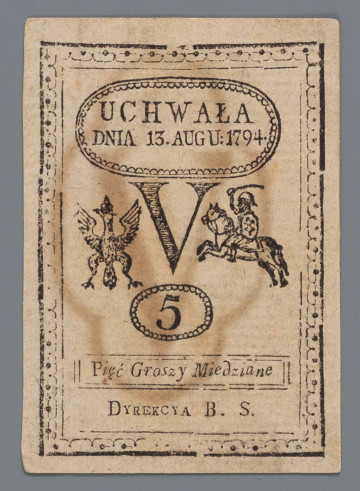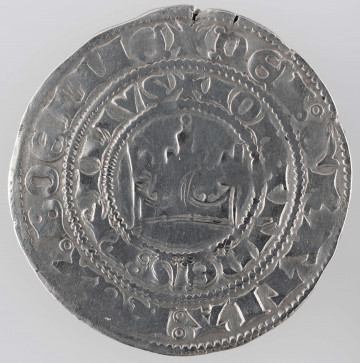
Gdańsk pfennig of Casimir the Jagiellon
1457 — 1492
National Museum in Lublin
Part of the collection: Money on Polish territory in the Middle Ages
During the Thirteen Years' War (1454-1466), Toruń, as one of the main centres of Prussia, was particularly involved in activities aimed at joining these lands to Poland. Therefore, shortly after the Act of Incorporation of March 6, 1454, King Casimir Jagiellon granted the burghers of Toruń the privilege to mint coins for the Prussian lands. Until 1457, shillings of a very high purity of silver were issued. Although the money was intended for the whole province, it contained symbolism related exclusively to Toruń. On the obverse, there is an eagle with a crown on its neck, resembling the later coat of arms of Royal Prussia, and on the reverse the coat of arms of the city of Toruń. In 1457, Gdańsk and Toruń, and soon also Elbląg were granted the right to mint municipal coins. In the case of Toruń and Elbląg shillings and small, brakteat fenges were issued. The new shilling, minted in Toruń since 1457, differed from its predecessor in reduced weight, which was related to bullion shortages. It also had a changed iconography. To mark its links with Poland, the coat of arms of the Jagiellonian dynasty, i.e., a double cross in a shield, was placed on the obverse, and an inscription was placed in the rim: KASIMIR D G REX POLONIE (Casimir by the grace of God King of Poland). On the reverse, there is an eagle with a crown on its neck and a claw raised above its head holding a sword. In the rim there is an inscription: MONETA THORVNENSIS (Toruń coin). The image of the eagle was taken from the new coat of arms granted to Royal Prussia in 1457 by Casimir Jagiellonian. On the one hand, it referred to the traditional Prussian eagle, but the crown on its neck indicated the connection with Poland, while the upraised sword was characteristic of the Lithuanian coat of arms. Both these elements, i.e., the crown and the upraised sword, symbolised not only the links with the Republic of Poland but also its sovereignty over Prussia. In the case of Toruń shillings, it is known that they were to be used as a means of payment not only in Prussia, but also in Poland. As such shillings were minted for a long time (from 1457 to at least 1492), there are many variants of them, differing in, among other things, mint marks placed at the beginning of the edge inscriptions, such as a star, crescent, circle, point or, as in the presented specimen, a cross.
Leszek Poniewozik
Author / creator
Dimensions
cały obiekt: diameter: 18,1 mm
Object type
numismatic
Technique
stamp minting
Material
silver
Creation time / dating
Creation / finding place
Owner
The National Museum in Lublin
Identification number
Location / status

1457 — 1492
National Museum in Lublin

1794
National Museum in Lublin

1310
National Museum in Lublin
DISCOVER this TOPIC
Museum of King Jan III's Palace at Wilanów
DISCOVER this PATH
Educational path